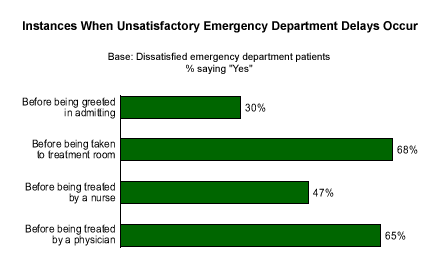In an emergency, there's nothing more frustrating than feeling you're being put on the back burner. That's why there is a direct relationship between the amount of time that patients wait for emergency treatment and their levels of satisfaction with their experience. Patients who wait for an average of 35 minutes or less tend to be satisfied, and those who wait for 72 minutes or more tend to be dissatisfied.
Being seen by a physician at a hospital emergency department is typically a multi-step process. Patients must be greeted upon arrival, taken to a treatment room, and be seen by a nurse and a doctor. Which stage of this process takes the longest, and which stages are patients most dissatisfied with?
Emergency Department Bottlenecks
To improve wait times and overall patient satisfaction with the emergency department, we must identify the location of the patient bottlenecks. While the circumstances are unique for each emergency department, an examination of results from ║┌┴¤═°'s 2002 patient satisfaction and loyalty database can provide some insight.
Approximately 20% of emergency department patients are dissatisfied with their wait times. ║┌┴¤═° provided these patients with a list of points in the emergency department process and asked them whether they encountered unsatisfactory delays before each one:
- Being greeted by someone in admitting
- Being taken into a treatment room
- Being treated by a nurse
- Being treated by a physician
There is wide variation in patient perceptions of where bottlenecks occur. Thirty percent of patients who were dissatisfied with their wait times said there was an unsatisfactory delay before being greeted in admitting, a relatively low figure compared to the 68% who were dissatisfied with the time it took to be taken to a treatment room and 65% dissatisfied with the delay before being treated by a physician. There is significant potential for improvement at every stage, but the two major bottlenecks are clearly the latter two phases.

How to Eliminate Bottlenecks
Patients go to emergency departments with urgent health needs that require a physician's treatment. Yet nearly two-thirds of patients who are dissatisfied with wait times experienced unsatisfactory delays before seeing a doctor. Dissatisfaction with this stage could indicate inefficiency in any or all of the steps leading up to this important point in the process, but there is undoubtedly an urgent need for physician-patient contact as early in the process as possible. Such contact may be occurring too late if it is always relegated to the final point in the chronological progression of emergency department treatment.
There are two basic strategies for improving patient satisfaction with the time it takes to see a physician. The first strategy is getting the patient to the physician as quickly as possible. Many hospitals have successfully addressed this issue by implementing bedside registration. But even this approach will fail if the patient then faces an extended wait in the treatment room before being treated by the physician. The question then becomes not how to get the patient to the physician faster, but how to get the physician to the patient faster.
What are the possible process implications of that reversal? An obvious one is to increase the number of physicians in the emergency department. But given resource constraints, many facilities will need to think in terms of more effective utilization of existing physicians. Why not free physicians from being bounded only to patient contact in the treatment room, and get them directly involved with the initial triage process in the front of the department?
Clearly, thought-process barriers exist to such a major reversal to the treatment paradigm. But perhaps such a major revolution is necessary to solve the emergency department crisis. This type of revolution worked with the implementation of bedside registration. Is earlier physician involvement the next step?